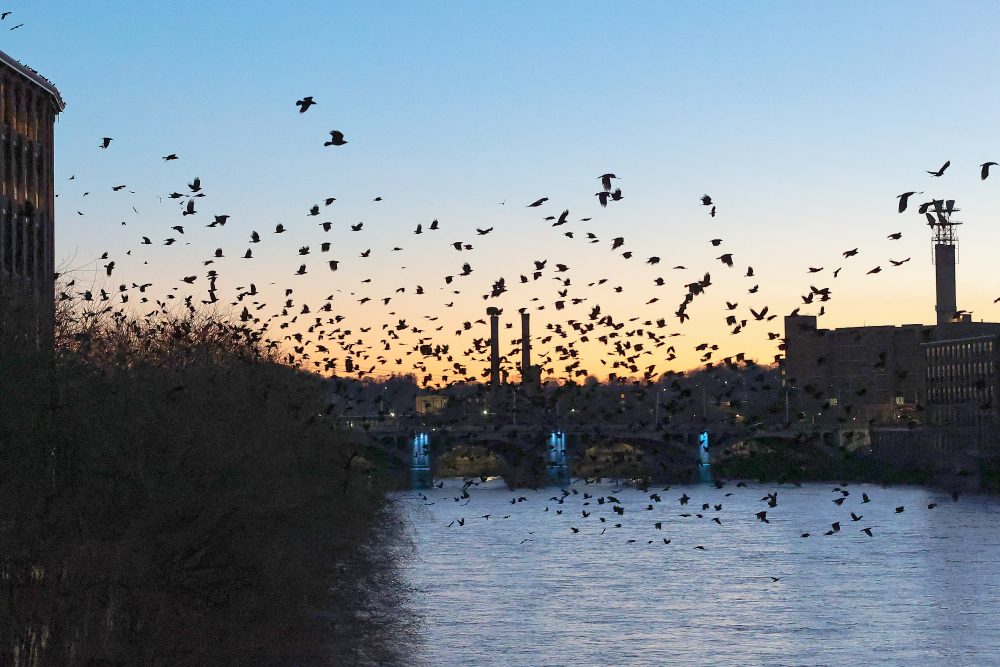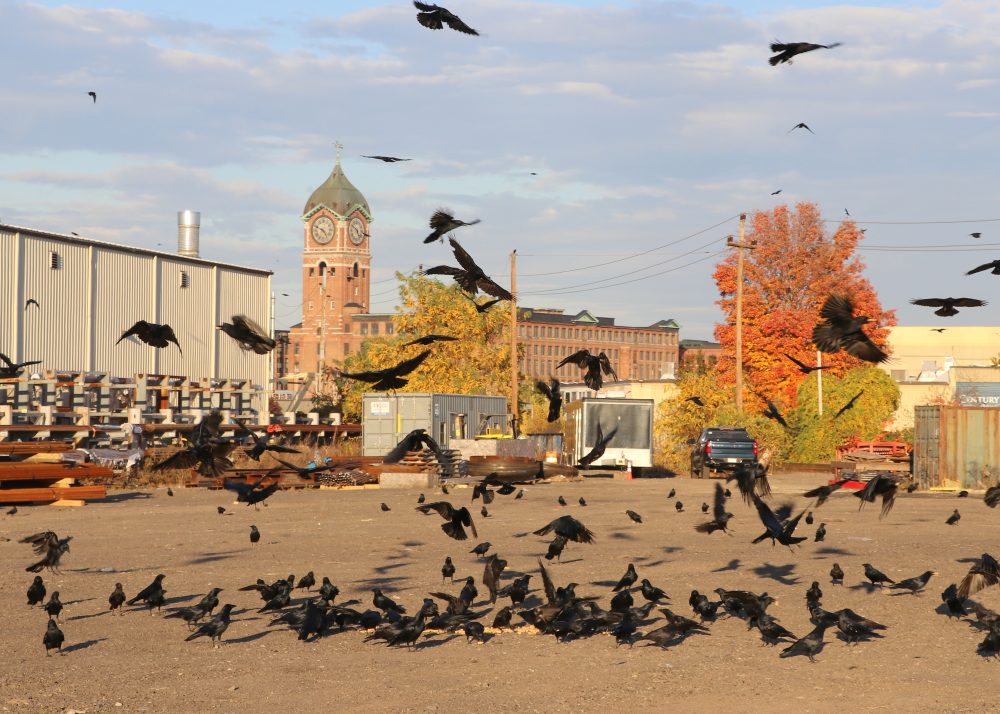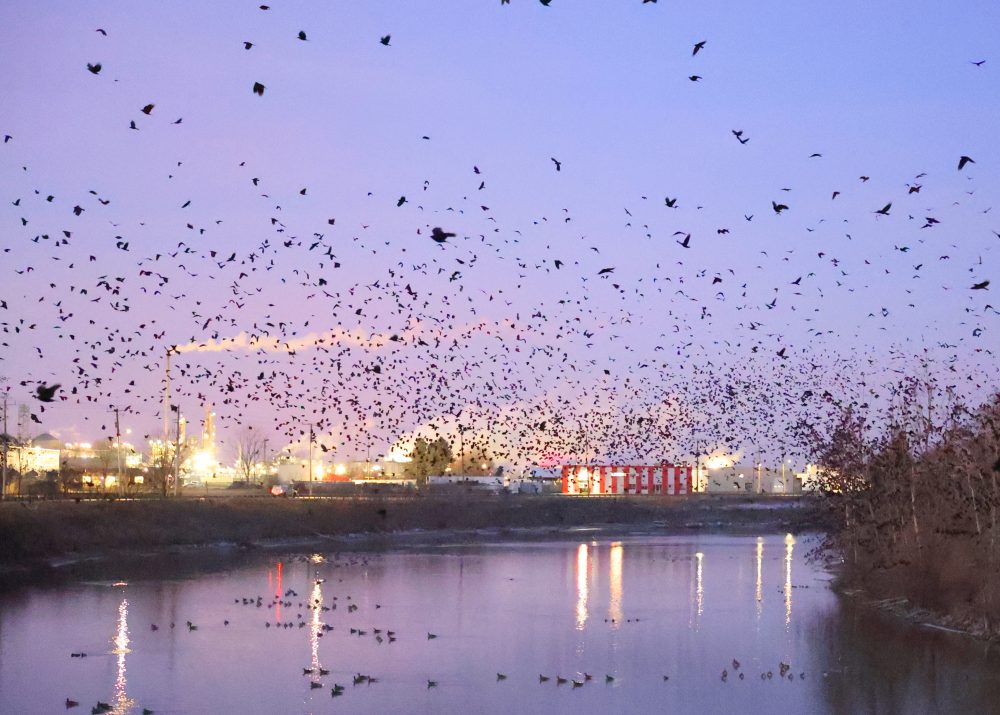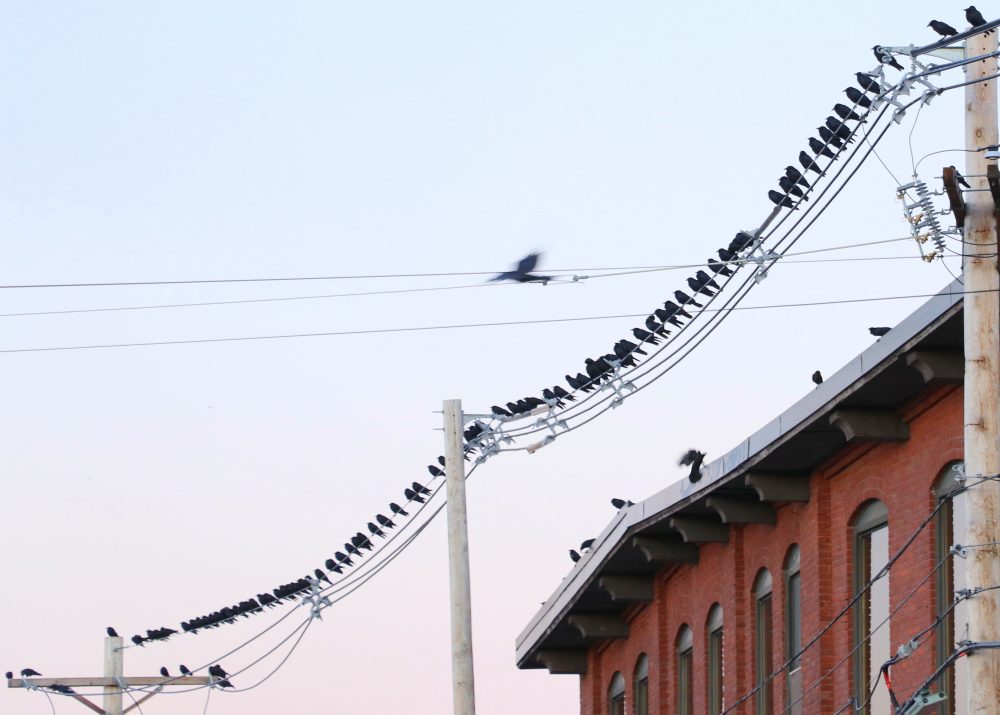Dec. 17, 2024: after a fascinating lunch discussion about American Crows and Fish Crows last Friday with birding friends, thought it might be interesting to share thoughts on how to differentiate these two similar species.
Telling an American Crow from a Fish Crow can be tricky, as the two species are nearly identical in appearance. However, there are several reliable ways to distinguish between them, especially in winter when large crow roosts make identification opportunities plentiful. While size is an obvious difference—American Crows are larger—it’s not always easy to judge body size in the field. Instead, the most effective way to separate these two species is by listening to their calls.

The American Crow has a classic, loud, resonant “caw, caw, caw,” often delivered in a series. Their call is deeper and fuller compared to the Fish Crow, which has a shorter, nasal, higher-pitched “uh-uh” or “cah-cah.” The Fish Crow’s call almost sounds as if it has a cold, making it distinctly different from the robust calls of the American Crow. Interestingly, an easier characteristic that sometimes helps distinguish the two crows is their posture when calling. The Fish Crow often fluffs its feathers, particularly around its neck, giving it a puffier appearance. In contrast, the American Crow remains smooth and sleek while calling, adding another visual clue to help with identification.
Another key difference is in their flight patterns. American Crows tend to have steady, purposeful wingbeats, with a slower and wider rhythm. Their flight looks deliberate, and their broader wings give them a sturdy silhouette in the air. In contrast, Fish Crows have quicker, more buoyant wingbeats and a slightly lighter, more agile flight style. This can give them a less lumbering look when flying.

Behavior around food and water can also provide clues. While both species are opportunistic scavengers, American Crows are generalists, foraging in fields, forests, urban areas, and sometimes near waterways. Fish Crows, on the other hand, are more strongly associated with aquatic environments. They are frequently seen along riverbanks, beaches, and estuaries, scavenging for fish or other waterborne prey. If you’re observing a crow closely tied to the shoreline or wetlands, it’s more likely to be a Fish Crow.

Perching habits offer another potential clue. Fish Crows are often observed perching on utility wires, especially in urban and suburban areas. American Crows will also perch on wires occasionally, but they seem to favor trees or open ground when roosting or foraging. While this isn’t a hard-and-fast rule, it’s another behavioral trait that can help tip the scales when identifying these birds.

By focusing on vocalizations, flight patterns, posture, feeding behaviors, and perching preferences, you can sharpen your skills at distinguishing between American Crows and Fish Crows. Winter crow roosts often include both species, providing a perfect opportunity to study them side by side. So, grab your binoculars, tune your ears to those calls, and enjoy the challenge of identifying these fascinating birds. You might be surprised by what you discover!
For the 2024 Audubon Christmas Bird Count (CBC) for the Andover Circle (MAAN), this separate Crow Count was 12,550 total Crows, including American Crows and Fish Crows. In 2023, the CBC Andover Circle Crow Count was 11,600. Many thanks to Donna Cooper who coordinates and compiles the CBC Andover Circle each year! Craig is the designated sector leader for the roost count.
The counts and methods meticulously developed by the Crow Patrol for the Lawrence roost were reviewed and approved in January 2021. This took place after a full review of all field notes and images, followed by group discussion with the New England Regional Editor for the CBC, full support from the National Director of the CBC, and Donna Cooper as the local CBC Count Circle compiler. After this comprehensive review process, the final count for American Crows for the 2020 CBC was set at 15,200. This final count reflected the detailed field reports and imaging provided by members of the Crow Patrol. This count number was also in total alignment with a long list of experienced local birders who have made prior counting visits to this winter roost in Lawrence, MA!
As a result of meaningful input from the National CBC Director, we are now using improved methods for counting the large number of Crows while streaming, staging, and settling into the roost. For all counts, we utilize multiple direct block counts of the Crows in flight and while the Crows are perched in trees, always while standing and walking around outside (not sitting in a car after dark) around the roost. For all images, we use a modified open source counting software program, to carefully document and cross check our count numbers. This comprehensive approach significantly increases the reliability and accuracy of our carefully documented results. Please refer to our newly published Winter Crow Roost counting guide PDF on the main page.
The Canon R6 mirrorless cameras excels in low-light photography due to its 24 MP sensor with fewer and larger pixels, allowing for better light collection and signal-to-noise ratio. It offers high dynamic range for detail retention, low digital noise even at high ISOs (up to 102,400), effective image stabilization for sharper images, and advanced image processing to minimize noise in dark areas.
The Canon mirrorless cameras with the RF 50mm f/1.2 lens and the RF 28-70mm F2 lens excel in low-light conditions, blending versatile focal lengths with an ultra-wide aperture. Both focal lengths work extremely well in very low light conditions, the f/1.2 and f2 aperture settings ensure exceptional performance in low light conditions, offering stunning clear, and aesthetically pleasing images, making them ideal for the challenging very low light conditions around any overnight winter crow roost.
Remember to check out the latest Crow Patrol Podcast with John Macone (Merrimack River Watershed Council): wintercrowroost.com/podcast/
Photo gear used for most outings:
Canon EOS 80D with Canon EF-S 18-135mm f/3.5-5.6 IS
Canon EOS 80D with Canon EF-S 18-135mm f/3.5-5.6 IS (Infrared)
Canon EOS R6 Mirrorless with Canon RF 28-70 f/2 L IS USM
Canon EOS R6 II Mirrorless with Canon RF 50 f/1.2 L USM
Sony AX700 4K HDR Camcorder
Follow us on Instagram: wintercrowroost
Follow us on YouTube: wintercrowroost


Leave A Comment